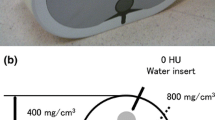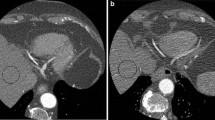Abstract
To evaluate the clinical value of a body mass index (BMI) based tube current (mA) selection method for obtaining consistent image quality with dose optimization in MDCT prospective ECG gated coronary calcium scoring. A formula for selecting mA to achieve desired image quality based on patient BMI was established using a control group (A) of 200 MDCT cardiac patients with a standard scan protocol. One hundred patients in Group B were scanned with this BMI-dependent mA for achieving a desired noise level of 18 HU at 2.5 mm slice thickness. The CTDIvol and image noise on the ascending aorta for the two groups were recorded. Two experienced radiologists quantitatively evaluated the image quality using scores of 1–4 with 4 being the highest. The image quality scores had no statistical difference (P = 0.71) at 3.89 ± 0.32, 3.87 ± 0.34, respectively, for groups A and B of similar BMI. The image noise in Group A had linear relationship with BMI. The image noise in Group B using BMI-dependent mA was independent of BMI with average value of 17.9 HU and smaller deviations for the noise values than in Group A (2.0 vs. 2.9 HU). There was a 35% dose reduction with BMI-dependent mA selection method on average with the lowest effective dose being only 0.35 mSv for patient with BMI of 18.3. A quantitative BMI-based mA selection method in MDCT prospective ECG gated coronary calcium scoring has been proposed to obtain a desired and consistent image quality and provide dose optimization across patient population.



Similar content being viewed by others
References
Reddy KS, Yusuf S (1998) Emerging epidemic of cardiovascular disease in developing countries. Circulation 97:596–600 PMid:9494031
McCarthy JH, Palmer FJ (1974) Incidence and significance of coronary artery calcification. Br Heart J 36:499–504. doi:10.1136/hrt.36.5.499
Rifkin RD, Parisi AF, Folland E (1979) Coronary calcification in the diagnosis of coronary artery disease. Am J Cardiol 44:141–148. doi:10.1016/0002-9149(79)90263-7
Eggen DA, Strong JP, McGill HC Jr (1965) Coronary calcification: relationship to clinically significant coronary lesions and race, sex, and topographic distribution. Circulation 32:948–955 PMid:5845254
Schmermund A, Baumgart D, Görge G et al (1997) Coronary artery calcium in acute coronary syndromes: a comparative study of electron-beam computed tomography, coronary angiography, and intracoronary ultrasound in survivors of acute myocardial infarction and unstable angina. Circulation 96:1461–1469 PMid:9315532
Mintz GS, Pichard AD, Popma JJ et al (1997) Determinants and correlates of target lesion calcium in coronary artery disease: a clinical, angiographic and intravascular ultrasound study. J Am Coll Cardiol 29:268–274. doi:10.1016/S0735-1097(96)00479-2
Baumgart D, Schmermund A, Goerge G et al (1997) Comparison of electron beam computed tomography with intracoronary ultrasound and coronary angiography for detection of coronary atherosclerosis. J Am Coll Cardiol 30:57–64. doi:10.1016/S0735-1097(97)00147-2
Arad Y, Goodman KJ, Roth M, Newstein D, Guerci AD (2005) Coronary calcification, coronary disease risk factors, C-reactive protein, and atherosclerotic cardiovascular disease events: the St. Francis Heart Study. J Am Coll Cardiol 46:158–165. doi:10.1016/j.jacc.2005.02.088
Haberl R, Becker A, Leber A et al (2001) Correlation of coronary calcification and angiographically documented stenoses in patients with suspected coronary artery disease: results of 1, 764 patients. J Am Coll Cardiol 37:451–457. doi:10.1016/S0735-1097(00)01119-0
Raggi P, Callister TQ, Cooil B et al (2000) Identification of patients at increased risk of first unheralded acute myocardial infarction by electron-beam computed tomography. Circulation 101:850–855 PMid:10694523
Vliegenthart R, Oudkerk M, Hofman A et al (2005) Coronary calcification improves cardiovascular risk prediction in the elderly. Circulation 112:572–577. doi:10.1161/CIRCULATIONAHA.104.488916
Wong ND, Hsu JC, Detrano RC, Diamond G, Eisenberg H, Gardin JM (2000) Coronary artery calcium evaluation by electron beam computed tomography and its relation to new cardiovascular events. Am J Cardiol 86:495–498. doi:10.1016/S0002-9149(00)01000-6
Achenbach S, Moshage W, Ropers D, Nossen J, Daniel WG (1998) Value of electron-beam computed tomography for the detection of high-grade coronary artery stenoses and occlusions. N Engl J Med 339:1964–1971. doi:10.1056/NEJM199812313392702
Becker CR, Knez A, Jakobs TF et al (1999) Detection and quantification of coronary artery calcification with electron-beam and conventional CT. Eur Radiol 9:620–624. doi:10.1007/s003300050720
Otero HJ, Steigner ML, Rybicki FJ (2009) The “Post-64” era of coronary ct angiography: understanding new technology from physical principles (Review). Radiol Clin North Am 47(1):79–90. doi:10.1016/j.rcl.2008.11.001
Rybicki FJ, Otero HJ, Steigner M et al (2008) Initial evaluation of coronary images from 320-detector row computed tomography. Int J Cardiovasc Imaging 24(5):535–546. doi:10.1007/s10554-008-9308-2
Steigner ML, Otero HJ, Cai T et al (2009) Narrowing the phase window width in prospectively ECG- gated single heart beat 320-detector row coronary CT angiography. Int J Cardiovasc Imaging 25(1):85–90. doi:10.1007/s10554-008-9347-8
Achenbach S et al (2009) High-pitch spiral acquisition: a new scan mode for coronary CT angiography. J Cardiovasc Comput Tomogr 3:117–121. doi:10.1016/j.jcct.2009.02.008
Gopal A, Budoff MJ (2006) Coronary calcium scanning. Am Heart Hosp J 4:43–48. doi:10.1111/j.1541-9215.2006.04682.x
General principles associated with good imaging technique: technical, clinical and physical parameters. http://www.drs.dk/guidelines/ct/quality/mainindex.htm, Chap 1, p 4
Halliburton S (2009) Options for reducing patient radiation dose with cardiovascular computed tomography. Int J Cardiovasc Imaging 25:153–164. doi:10.1007/s10554-009-9450-5
Budoff MJ, Gul KM (2008) Expert review on coronary calcium. Vasc Health Risk Manag 4:315 PMid:18561507 PMCid:2496978
Hausleiter J, Meyer T, Hadamitzky M et al (2006) Radiation dose estimates from cardiac multislice computed tomography in daily practice: impact of different scanning protocols on effective dose estimates. Circulation 113:1305–1310. doi:10.1161/CIRCULATIONAHA.105.602490
Einstein AJ, Henzlova MJ, Rajagopalan S (2007) Estimating risk of cancer associated with radiation exposure from 64-slice computed tomography coronary angiography. JAMA 298:317. doi:10.1001/jama.298.3.317-323
Wilting J, Zwartkruis A, van Leeuwen MS (2001) A rational approach to dose reduction in CT: individualized scan protocols. Eur Radiol 11(2):2627–2632. doi:10.1007/s003300101039
Mahnken AH, Wildberger JE, Simon J, Koos R, Flohr T, Schaller S et al (2003) Detection of coronary calcifications: feasibility of dose reduction with a body weight-adapted examination protocol. Am J Roentgenol 181:533–538
Das M, Mahnken A, Muhlenbruch G et al (2005) Individually adapted examination protocols for reduction of radiation exposure for 16-MDCT chest examinations. Am J Roentgenol 184:1437–1443
Gao J, Li J, Earls J, Li T et al. (2010) Individualized tube current selection for 64-row cardiac CTA based on analysis of the scout view. Eur J Radiol (in press). doi:10.1016/j.ejrad.2010.04.026
Fei X, Du X, Li P, Liao J, Shen Y, Li K (2008) Effect of dose-reduced scan protocols on cardiac coronary image quality with 64-row MDCT: a cardiac phantom study. Eur J Radiol 67:85–91. doi:10.1016/j.ejrad.2007.07.008
Acknowledgments
Special thanks to Haipeng Dong, Zhenfang Wu, Weipin Shi, and Heshi Liu for their important contributions.
Author information
Authors and Affiliations
Corresponding author
Rights and permissions
About this article
Cite this article
Pan, Z., Pang, L., Li, J. et al. Achieving consistent image quality with dose optimization in 64-row multidetector computed tomography prospective ECG gated coronary calcium scoring. Int J Cardiovasc Imaging 27, 611–617 (2011). https://doi.org/10.1007/s10554-010-9701-5
Received:
Accepted:
Published:
Issue Date:
DOI: https://doi.org/10.1007/s10554-010-9701-5




